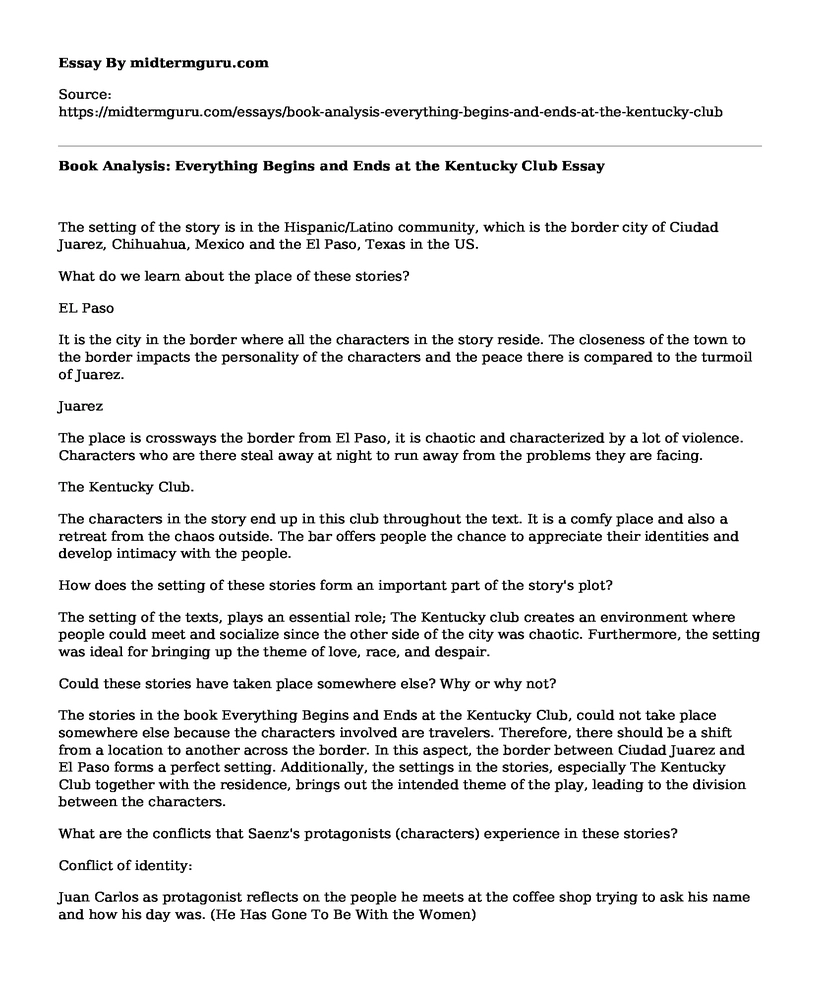The setting of the story is in the Hispanic/Latino community, which is the border city of Ciudad Juarez, Chihuahua, Mexico and the El Paso, Texas in the US.
What do we learn about the place of these stories?
EL Paso
It is the city in the border where all the characters in the story reside. The closeness of the town to the border impacts the personality of the characters and the peace there is compared to the turmoil of Juarez.
Juarez
The place is crossways the border from El Paso, it is chaotic and characterized by a lot of violence. Characters who are there steal away at night to run away from the problems they are facing.
The Kentucky Club.
The characters in the story end up in this club throughout the text. It is a comfy place and also a retreat from the chaos outside. The bar offers people the chance to appreciate their identities and develop intimacy with the people.
How does the setting of these stories form an important part of the story's plot?
The setting of the texts, plays an essential role; The Kentucky club creates an environment where people could meet and socialize since the other side of the city was chaotic. Furthermore, the setting was ideal for bringing up the theme of love, race, and despair.
Could these stories have taken place somewhere else? Why or why not?
The stories in the book Everything Begins and Ends at the Kentucky Club, could not take place somewhere else because the characters involved are travelers. Therefore, there should be a shift from a location to another across the border. In this aspect, the border between Ciudad Juarez and El Paso forms a perfect setting. Additionally, the settings in the stories, especially The Kentucky Club together with the residence, brings out the intended theme of the play, leading to the division between the characters.
What are the conflicts that Saenz's protagonists (characters) experience in these stories?
Conflict of identity:
Juan Carlos as protagonist reflects on the people he meets at the coffee shop trying to ask his name and how his day was. (He Has Gone To Be With the Women)
Conflict of language as identifying:
The authors describe how language is strongly related to the individuals' identity. The characters in the story are of Mexican origin. While at El Paso, their residence which is close to the border, they are forced to challenge their dual identity. They are both speakers of English and Spanish; however, some characters embrace their Spanish speaking culture, while for others it is a distant part of their identities. They recognize Spanish as part of Mexican heritage, but they don't speak it.
Conflict of race:
Racism led to the attack of Nick, by the xenophobic white men
Family conflict:
Both Charlies family are in despair; they lack unity leading to the hopelessness among the characters.
What source of tension or conflict do they endure?
There is the tension of racism, crime, tragedy, family conflict, and separation.
How do they resolve or fail to resolve those conflicts?
In the conflict relating to race, in the story The Art of Translation, Nick has to learn again the meaning of the words used by the language of xenophobic white men, as he recovers from the brutal race-bashing.
What are the themes that emerge in these three stories?
Tragedy and race: Nick is injured and hospitalized after being attacked by xenophobic white men
(The Art of Translation).
Love and relationship:
In the story, He Has Gone To Be With the Women," Juan Carlos gets attracted to a man in a coffee shop, and they together fell in love and had an intimate relationship.
Family conflict:
Charlie attempted to commit suicide in his parents bedroom but failed. He is the conflict with his further who he claims burnished his father, and even he does not love his mother at all, which prompted his suicide attempt.
What questions does Ben Saenz seem to be asking about the human condition, the world?
The author, Ben Saenz, appears to be asking issues related to crime, family relationship, race and identity, bisexual relationship and conflict resolution method.
Indicate these issues by writing them in question form. Do any of these stories answer those questions? Why or why not?
On which way, could one resolve a family conflict?
Does embracing the other peoples culture away to resolve racism?
Can our daily activities separate us from our loved ones?
Do you think it's important for writers to answer the questions they implicitly or explicitly ask in the course of a story? Why or why not?
It was necessary for the writer to answer the question to fulfill the theme of the story completely and also, not to leave the readers in suspense.
Cite this page
Book Analysis: Everything Begins and Ends at the Kentucky Club. (2021, May 31). Retrieved from https://midtermguru.com/essays/book-analysis-everything-begins-and-ends-at-the-kentucky-club
If you are the original author of this essay and no longer wish to have it published on the midtermguru.com website, please click below to request its removal:
- Literature Essay Example: The Power of Death and Nature in Poems
- Anarchy in Fight Club by Chuck Palahniuk - Literary Analysis Essay
- Literary Analysis of Kate Chopin's "The Story of An Hour"
- Essay Sample on England's First Feminist Mary Astell
- A Comparison of Beowulf, Sir Gawain, and the Green Knight - Essay Sample
- Beowulf Literary Analysis Essay Sample
- Literary Analysis Essay on "Pheno Timers", "For Me From You "And "the Poem at Thirty-Nine"







